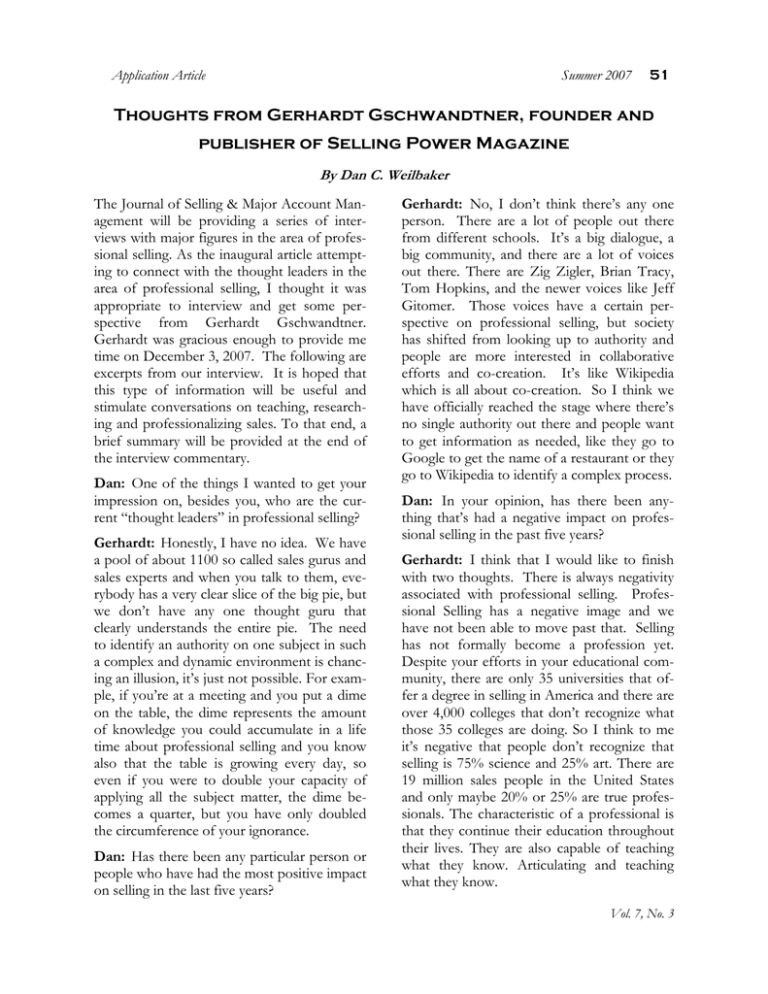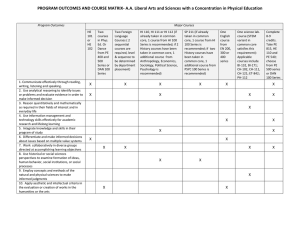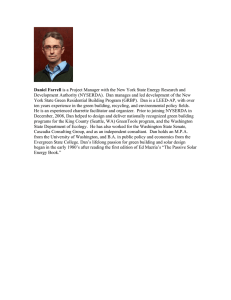Thoughts from Gerhardt Gschwandtner, founder and publisher of Selling Power Magazine
advertisement

Application Article Summer 2007 51 Thoughts from Gerhardt Gschwandtner, founder and publisher of Selling Power Magazine By Dan C. Weilbaker The Journal of Selling & Major Account Management will be providing a series of interviews with major figures in the area of professional selling. As the inaugural article attempting to connect with the thought leaders in the area of professional selling, I thought it was appropriate to interview and get some perspective from Gerhardt Gschwandtner. Gerhardt was gracious enough to provide me time on December 3, 2007. The following are excerpts from our interview. It is hoped that this type of information will be useful and stimulate conversations on teaching, researching and professionalizing sales. To that end, a brief summary will be provided at the end of the interview commentary. Dan: One of the things I wanted to get your impression on, besides you, who are the current “thought leaders” in professional selling? Gerhardt: Honestly, I have no idea. We have a pool of about 1100 so called sales gurus and sales experts and when you talk to them, everybody has a very clear slice of the big pie, but we don’t have any one thought guru that clearly understands the entire pie. The need to identify an authority on one subject in such a complex and dynamic environment is chancing an illusion, it’s just not possible. For example, if you’re at a meeting and you put a dime on the table, the dime represents the amount of knowledge you could accumulate in a life time about professional selling and you know also that the table is growing every day, so even if you were to double your capacity of applying all the subject matter, the dime becomes a quarter, but you have only doubled the circumference of your ignorance. Dan: Has there been any particular person or people who have had the most positive impact on selling in the last five years? Gerhardt: No, I don’t think there’s any one person. There are a lot of people out there from different schools. It’s a big dialogue, a big community, and there are a lot of voices out there. There are Zig Zigler, Brian Tracy, Tom Hopkins, and the newer voices like Jeff Gitomer. Those voices have a certain perspective on professional selling, but society has shifted from looking up to authority and people are more interested in collaborative efforts and co-creation. It’s like Wikipedia which is all about co-creation. So I think we have officially reached the stage where there’s no single authority out there and people want to get information as needed, like they go to Google to get the name of a restaurant or they go to Wikipedia to identify a complex process. Dan: In your opinion, has there been anything that’s had a negative impact on professional selling in the past five years? Gerhardt: I think that I would like to finish with two thoughts. There is always negativity associated with professional selling. Professional Selling has a negative image and we have not been able to move past that. Selling has not formally become a profession yet. Despite your efforts in your educational community, there are only 35 universities that offer a degree in selling in America and there are over 4,000 colleges that don’t recognize what those 35 colleges are doing. So I think to me it’s negative that people don’t recognize that selling is 75% science and 25% art. There are 19 million sales people in the United States and only maybe 20% or 25% are true professionals. The characteristic of a professional is that they continue their education throughout their lives. They are also capable of teaching what they know. Articulating and teaching what they know. Vol. 7, No. 3 52 Journal of Selling & Major Account Management The other negative that’s also a positive is the whole area of technology that is related to selling. There are so many new technologies introduced to the sales profession. Four years ago a company that had a choice of about 800-900 technology solutions but today, four years later, we have about 19,000 technology solutions. But when you look at the sales statistics over the last four years, you see a flat curve. You don’t see any improvement. So the question is “why hasn’t sales productivity improved?” With all that technology in place, every one of those technologies was supposed to improve productivity, but in reality is doesn’t. So the answer is that any technology piece is like an only child that’s spoiled by two parents and doesn’t want to collaborate. They want to be the center of attention. Every piece of sales technology out there, they don’t really want to collaborate with all the other technologies. I have an iPhone that doesn’t want to collaborate with Verizon. I can give you a lot of examples like that. Technology is a negative to me because the technologies haven’t found out how to collaborate with other technologies to help sales people to work smarter, not harder. Dan: Do you know of any companies or any industries that are making proactive decisions where they’re actually preparing for the mass exodus of baby-boomer salespeople? Gerhardt: Honestly, I don’t know of any companies that specifically have a strategy for doing that. Every sales force needs young people to look at the future with bright eyes and they often need the older people in order to be a guiding force to remind people of what they’ve learned from their experience in the past. Dan: I see some numbers that say there will be a 3 million person deficit even if everybody that was able to go into sales did go into sales. Any thoughts on how companies can handle or prepare for this? Northern Illinois University Gerhardt: I’ve talked to a company that has 1600 sales people and needs to hire 400 more next year. They’ve had disappointing results using a recruiting firm and the traditional sources are no longer satisfied with them and they say, “we are thinking outside the box”, and I’ve heard success stories that say “well I met a bartender who’s now making $50,000”. There’s a lady immigrated from Afghanistan who, two years ago was cleaning restaurants and they said they related to her social skills and now she’s making $130,000 plus. Somebody said, literally, they hired a forklift operator who became an account manager. So the art of spotting talent, we have to wear a different set of lens and not just stare at the same talent pool that we have looked at before. Dan: So immigration will be part of it, nontraditional sources, you know looking inside of your own company. Gerhardt: I don’t want to mention this either, but teachers are a great source for sales. Teachers don’t make a great amount of money and they know how to do great presentation and how to educate their customers. Another good pool is the Military. They focus on ex-marines and ex-navy people and they have a wonderful amount of skills. Leadership skills, process skills, execution skills, and the teamwork skills that is so critical for sales. A lot of them are fast learners and they can quickly learn the other skills that are needed by the company. Dan: What do you think about Universities as another non-traditional source for some companies? Non-traditional because a lot of companies just don’t hire from university setting because they are looking for some experience or a certain set of skills. Gerhardt: Well I think that the universities that teach sales have a great advantage over them because they teach them how to cold call or use sales letter or use a CM tool or handle objections or how to close. Those Application Article candidates are prime candidates and I think that what needs to be done is, the success that you have had at your school needs to be shared with the 4,000 other colleges that don’t teach sales. Summer 2007 53 The other trend is that companies created customers. This is about to change. In the future, it’s going to be the other way around. The customers will create companies. Dan: What do you think that the trends are for inside (telephone) business-to-business selling and outside? Are there trends? I know five years ago there was a huge influx in inside sales. Is that waning? Is that still going strong vs. the outside sales person? Dan: Do you have any particular views or opinions about the teaching of professional sales in the university setting? You mentioned earlier that there are very few, but is this a positive thing? Should the people who are teaching it be academically qualified as well as business qualified? Gerhardt: Well, there definitely is a trend towards both. You have to analyze sales incomes. What do customers want? They want to buy online, they want to buy over the phone and they want to buy face-to-face. Companies increasingly want their customers to buy the way they want to buy. That’s the future of the sales profession, really. A lot of stuff has moved online already and it has not diminished the need for or the number of sales people. What we have seen in our research is that the manufacturing sector is decreasing. They are selling more now, with fewer sales people, than they were 3 years ago. The service sector is expanding dramatically. There is continuous need for great service sales people and the skills that they’ll need to have as well as business acumen. Gerhardt: I think that, as I said earlier, we live in an age that intelligent collaboration is our future. Our future depends on that. Our world is moving away from the model of the single authority. We noticed this in our magazine about 3 years ago. When we do cover stories on people and personalities, they no longer have the impact where people inhale that “let’s learn all about Donald Trump”. People aren’t interested in a single source of authority. They are interested in a multitude of ideas and points of view. So when you’re teaching in a university I would bring in more real-life voices and have more discussions with the VP’s of sales, with sales managers, with sales trainers, with CEO’s who could coteach with the professors. I see the role of the professor more of an orchestra leader than an opera star. A lot of the information technology has limited and locked out the knowledge advantage that salespeople have had in the past, but what they’re looking for is the business acumen. Understanding more from the customer’s dashboard because sales people go out and their purpose is to create a customer. How do you create a customer? By helping the customers win. So, how do you help a customer win? By looking at what’s on the customer’s dashboard, which means you have some business insight to the customer’s numbers, to the customer’s profits, to the customer’s way of doing business. So that’s the way future sales are made. Dan: What are some of the issues that are keeping some of the academic research from reaching the field? Gerhardt: Well, I’ve read some of the academic research papers and there is a lot of science and a lot of work that goes into it. However, the outcome, the net take away, requires such a huge effort for a sales leader to begin to adapt that it doesn’t have a chance of getting read. It’s not immediately accessible and my suggestion would be…if the academics were forced to create a one minute elevator pitch on their research paper that in 60 seconds communicates what the content is and Vol. 7, No. 3 54 Journal of Selling & Major Account Management why it’s important, you would get a lot higher reaction. Because people do have a minute and if you add a short concise intro to the research paper you’d get a lot higher reaction. You know if they would be able to create Cliff’s Notes for the research or a one page executive summary that clearly spells out the benefit, then they would sell a lot more research. They would find a lot more sponsors and readers. Dan: Unfortunately it’s not the sponsors that we’re worried about, speaking as an academic, it’s the tenure process that really gets to us. There are only certain journals recognized by the university. I know there are limitations because I have to deal in that world too. That’s one of the reasons that Northern Illinois University has decided to publish the Journal of Selling and Major Account Management. We felt that the objective of trying to blend together the academics and the practitioners was a worthwhile thing. We’re trying to tell the academics that, “Ok, you’ve got to put the science in it, but let’s really beef up the managerial implications and give salespeople and sales managers something that they can use. What advice would you give to me as a new editor of the JSMAM, that is looking at both academic and practitioner issues? Is there anything we can do to better marry the academics and the practitioner as far as professional selling goes? Gerhardt: You have to look at the assets that the practitioner brings to the table and the asset of the academic. Now the academic obviously has a different perspective on everything, but it’s more methodical, more detailed, it’s much richer. It’s like comparing a 20 mega pixel camera to a cell phone camera. The academic is the 20 mega pixel camera. It’s high resolution. But on the other hand, the purpose of taking a picture for the practitioner is not for getting those details. They are communicating on another channel. They use the Northern Illinois University phone to make conversation, to sell ideas and install confidence. To merge the two it’s like oil and water. Dan: How do we get the emulsion made? We need to shake it up and get them, one dispersed within the other. Is there anything that, as the editor of the journal, that I could do to facilitate that? Gerhardt: You are held hostage by your own kind because they want to get published, they need to get published and they need to have some evidence that they’ve done their research and documented that. It’s manufacturing, but the end-user that you’re talking about, that you’re trying to help, is not interested. They are more interested in “what can you show me today that is related to my reality today?” You’re mixing virtual reality with real reality. The only way out is to create a dialogue to supplement the magazine. So, to make the magazine live and have the journal be relevant is to meet the constituents and have real conversations with them. Dan: What, in your opinion, are the greatest challenge facing sales people today? Gerhardt: It’s always the same. It’s not standing in the way of the sale. Sales people always want to have a silver bullet. We need a silver bullet. The thing is that you can give up the notion of the silver bullet when you respect the golden rule. The golden rule is “sell the way the customer wants to buy”. Dan: So that’s what’s getting in people’s way? They don’t sell the way the customer wants to buy? Gerhardt: That’s right. They either don’t understand the customer’s needs, or they don’t understand the customer’s psychology, or they don’t understand the customer’s economic power, or whatever. There’s a lot of misunderstanding because a lot of sales people think that knowing the product and knowing the benefits will help them sell, but it doesn’t. The customer will help you sell. Application Article Dan: What are the challenges that you think will be facing sales people in the future? Gerhardt: One of the biggest is how to integrate technology. How do we manage change for yourself and your customer? How do we grow as an individual? People like to be in a groove. The magic is not how can I become successful, but in a consistent success. One kind of success is a shooting star. The consistent success is a shining star. And that’s what people need to strive for. The skills for making a one time success are completely different skills for becoming that shining star. Consistent success not only requires a methodology, but also an ongoing commitment to changing and growing and looking at the world all the time and continually search out what is possible that people say can’t be done. So if you are constantly attracted by searching for the possible that can’t be done, you’ve got it made. A lot of people are afraid of that. This is what the sweet spot of success is. Dan: Those are basically most of the questions that I had. Any more parting shots that you want to give me? That you would like to expound upon in an article? Gerhardt: One thought that we have hinted on, is that selling is about the whole person and not just…you can’t wear a professional mask. You have to develop a professional identity. And as a professional we talk about the entire person. It means that you can manage yourself as a person in a professional way that you have an exercise routine that you watch what you eat, that you conduct yourself as an outstanding citizen, that you are known for making an outstanding contribution to society, so that the entire persona stands up as an example to others. That is something that a lot of companies don’t pay attention to. A lot of companies have a corporate culture that defines them, it’s what they stand for, this is our code of conduct, and this is how we collaborate. But in essence, what customers respond to is not the bells and whistles, but they Summer 2007 55 are buying from an individual, a person who they trust. I think that we trust people that don’t over promise and under deliver, we trust people who practice ethics. But also, we trust people where we get the impression that they are people of value or people of substance. People that are going to be there when you need them. Those are the people that we can go to when there’s crisis. That’s what I mean by, try to be a person of value. Then you have much more credibility in the value creation process for the customer. Major Conclusions After reflecting on Gerhardt’s thoughts there were four major issues that emerged to me. The first dealt with sales as a profession. That is there are so many different types of selling positions and so many ways to sell that there is no single thought leader or issue that could have all of the answers. Professional sales encompass a wide variety of activities and responsibilities. There is little in the way of decision rules or written in stone criteria that make sales people successful. I often tell my students that professional selling in not a cook book. Success depends on addressing each situation properly. Maybe that is why salespeople are so highly paid? The major issue appears to be professionalism. Even though sales is not viewed as a profession yet, there are definitely a move in that direction. One negative area that still plaques the profession is that the popular media never depicts salespeople as ethical or customer centered. Until that change the sheer mass of people influenced by the negative stereotype will prevent the profession from being positive. The positive area that has helped is that several universities, including the University Sales Center Alliance, are making a positive impact on the perception of the salesperson. Sales students are learning that sales are more about the customer and less about them. Gerhardt felt that even though this was a positive impact the sheer numbers Vol. 7, No. 3 56 Journal of Selling & Major Account Management of schools that do not teach professional selling will keep the image negative for a long time. The third issue dealt with how to replace the retiring baby-boomer salespeople. Gerhardt feels that the traditional methods will not be sufficient since the demand will be so much greater than supply. Instead non-traditional areas need to be explored. Some of those areas are ex-military, immigrants, teachers and universities that teach professional selling. Finally, the biggest issue for the future is getting technology to work together so that salespeople can sell more efficiently. This will allow for more co-creation and collaboration between the salesperson and customer. With out salespeople and customers working together there is little hope that sales will go beyond the negative perception that salespeople are out for themselves and not the customer. Dan C. Weilbaker, Ph.D., is McKesson Professor of Sales at Northern Illinois University. dweilbak@niu.edu. Northern Illinois University







